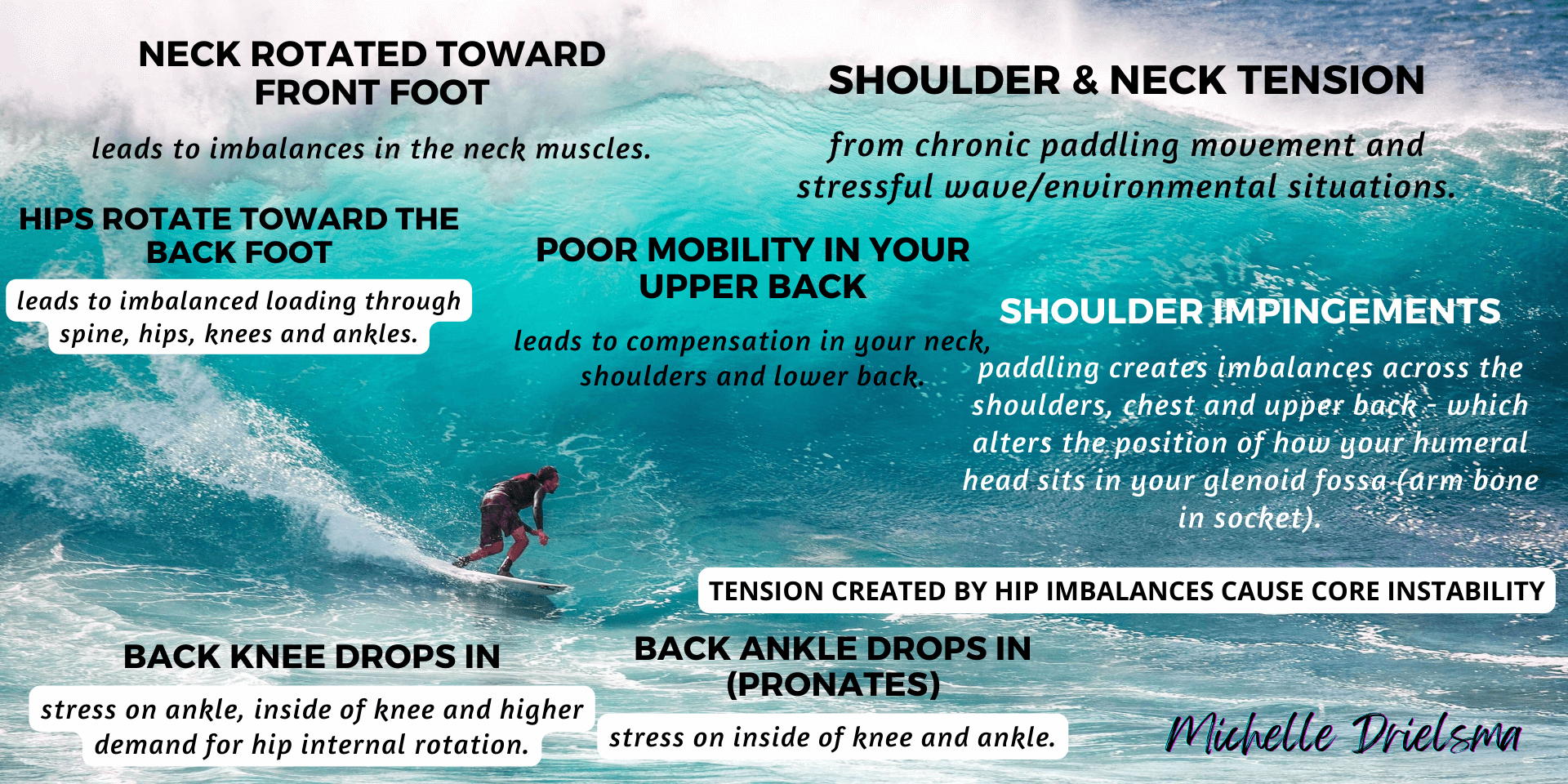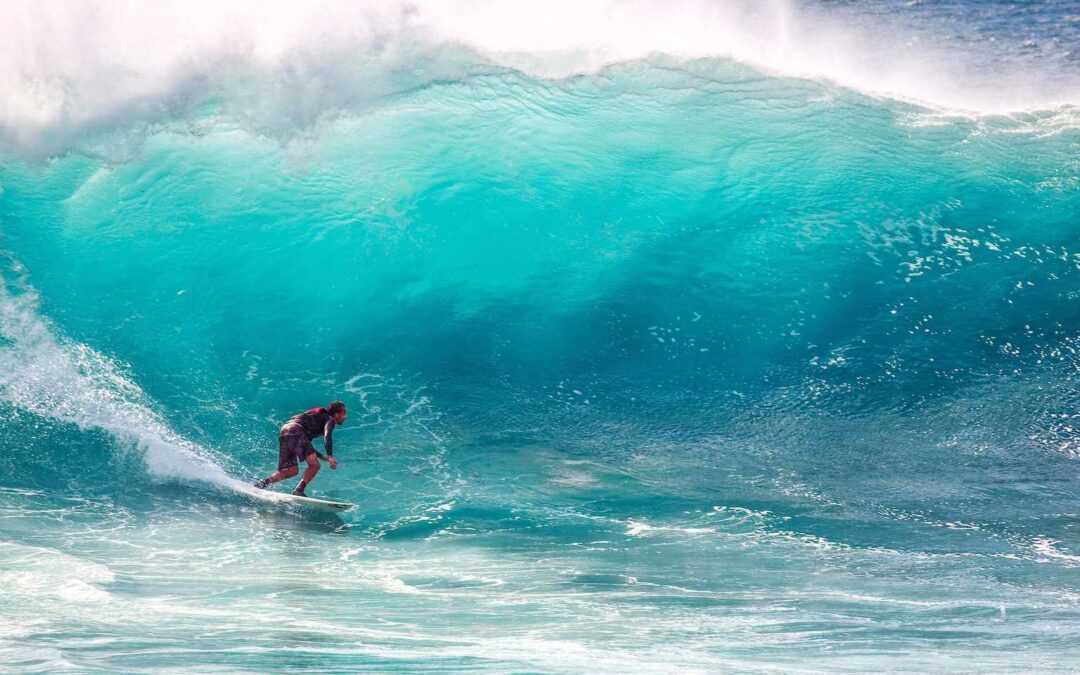“Don’t put training ahead of surfing. There’s no training for surfing like surfing itself. Training is mainly a way to prevent injuries while you’re surfing, by building strength in your body. Swimmers can go up and down the pool all day long, but eventually they have to go into the gym to balance out their body or strengthen up their shoulders, otherwise they are just going to blow something out. Same with surfing. You develop overuse patterns and you start blowing things out left, right and centre.” – Mick Fanning, Surf For Your Life.
I came to surfing fairly late in life. I had toyed around with the idea of learning to surf in my early teens, yet it wasn’t until around 10 years later I decided that in order to improve, I needed to get out there everyday. So, without the advantage of being a grom early in life, I then became a 26 year old frother – stoked on a new passion and outlet for my natural tendency to exercise and train more than the average female. The surf became my loyal physical, mental and emotional dumping ground. It also became my physical, mental and emotional energy tap. I think there’s something pretty healing about the ocean and it just feels good to be in it.
The first time I found myself going across the wave face, I was hooked like anyone else who’s done the same. Being older, my body was less pliable and forgiving than would be of the typical young grom, so I experienced a fairly strong change in the way my joints and muscles felt once I began to practice every day. Being an exercise physiologist and trained in dance since the age of three, I’ve grown to be aware of optimal spine and joint postures and have developed a high sense for proprioception (the position of my body in space). Surfing seemed to be challenging everything I had learnt in the past about keeping the body symmetrically conditioned and aligned. Some of the dysfunctions I see in my surfing clients, as well as what I was seeing within my own body include:
Upper back hunching over.
Head poking forward.
Pelvis rotating away from the front leg in standing, with the torso rotating toward the front leg.
Pop-ups are one-sided –twisting the body to the same side in each powerful pop-up, creating imbalances. Power = more force traveling through the body.
Back knee dropping in which creates and inward stress on the knee joint.
Back ankle dropping in (pronating) which creates an inward stress on the ankle and transfers that stress up to the knee, hip and beyond.
Shoulders and neck tightness and soreness from loads of paddling. Overtrained shoulder internal rotators.
A shrinking ass and an aching lower back.
These were the challenges I was facing as a rehabilitation and strength specialist, yet my own muscle and joint issues surfacing were not enough to detract me from my passion to become a better surfer and keep surfing for the rest of my life. This is why I am passionate about teaching surfers how to look after their bodies and perform to the best of their ability, so they can squeeze out more years and expertise in what they love to do most, just as I wish for myself.
Surfers often jog or run, do sit-ups, push-ups, ride bikes, and may even pump iron or do yoga. But rarely do they actually practice movements they’ll need on the board or work specific muscle groups that they’ll use in surfing.
An average ride lasts less than sixty seconds, and on a good day, you’re doing well to catch ten waves per hour. That adds up to less than ten minutes of practice time for each hour you spend in the water. Compare this to skiing or snowboarding – runs are usually limited only by conditioning. On a good hill, a single run might equal an entire day of surfing in terms of time spent building muscle memory by actually doing the activity. Especially at the beginner to intermediate stages of surfing, the ratio of paddling to standing up is even greater than it is for advanced surfers. Surfers also need to wait for decent swell in conjunction with surfable wind conditions, and in a spot that is not trying to accommodate 50+ surfers at once, which never happens?! So as a surfer, and especially if you were a late starter, you’re facing a very steep learning curve. A solution is to practice key moves in a controlled environment, just like athletes in other sports. Surf-specific training comes into play here. Flexibility, agility, strength, conditioning, power, and practice doing the things you would actually do to catch and ride a wave.
That’s the performance side of surfing, and then there’s the injury side, which can slowly happen (or quickly with impact situations) as your body morphs into what is required in surfing as a unilateral (one-sided) sport. What this means is that the act of paddling is fairly symmetrical, yet once you get ready for the wave and from the moment you push up and bring one leg further forward than the other, you are now asymmetrical for the rest of your ride. Your hips are rotated, your back ankle and knee drop in, your torso is rotated, your neck is rotated to see where you’re going, and if you’re like most people, you favor rights or lefts. If you are genius enough to surf switch-foot, you could potentially save yourself a lot of chronic overuse injuries, but this is rarely mastered.
What I See

Neck
The neck gets pulled into hyperextension with paddling and surfacing from duck-dives, especially for those with long hair who throw their heads back to prevent hair from covering their faces when they surface. Older surfers with immobile thoracic spines compensate by hyperextending their necks more than surfers who can lift the top of their chests off the board, leading to overextension at their shoulders and resulting in a sore, stiff neck.
Shoulders
If you already have a forward-neck-hunched-shoulders desk posture before you begin surfing, you’re off to a bad start. Your shoulder is probably already off balance by sitting forward in the shoulder socket. The action of paddling (and swimming) strengthens the larger muscles around the shoulder such as the pecs, front of the shoulders, lats, upper trapezius, and shoulder internal rotators. These muscles, when strong relative to their opposite acting muscles (like the back of the shoulder, lower trapezius, and shoulder external rotators), can actually pull your arm bone forward in your shoulder socket so that it doesn’t sit in its normal (anatomical) position. This leads to shoulder pain, neck pain, shoulder impingements, and hopefully, you’ll sort it out before developing rotator cuff tears.
Thoracic Spine
Restricted movement in the thoracic spine means other areas have to compensate – usually your shoulders start wearing away, and your lower back can develop some serious strain.
Lower Back
Wipeouts and the associated twists and turns forced upon the torso can strain the back. Additionally, any sudden movements have the potential to damage a poorly conditioned back, as well as the strain that can develop from prolonged paddling if the glutes and lower back muscles are not well conditioned. When the glutes and lower back are not well conditioned, prolonged paddling can create a shear force around the sacroiliac joint (SIJ) and lumbosacral region (lower back – hip/pelvis junctions).
Groin
Inflexible adductors (inner thigh muscles), chronic scar tissue in the adductors, poor squat technique, and inadequate warm-up can all contribute to groin strains.
Hips
Restricted hip mobility often leads to compensatory movements in adjacent areas, such as the lower back and knees. Both the lower back and knees may need to rotate and bend more than usual to achieve a deeper squat.
Surfing also contributes to tight hip flexors due to the repetitive motion of popping up and waiting on the board for a set.
During the act of standing up on a wave, the hips are rotated. The hip rotates toward the back foot (while the torso rotates toward the front foot), resulting in imbalanced loading through the spine, hips, knees, and ankles over time.
These imbalances can lead to core instability caused by tension in the hips.
Knees
The back knee drops inward, a technique required for good surfing and not something we want to change, but it does create stress on the inside of the knee and can lead to knee pain. Strengthening for knee stability and practicing good squat technique in the gym will reduce the likelihood of needing a knee reconstruction later down the track.
Ankles
Apart from occasionally enduring impact trauma (like any other joint in the body), the back ankle drops in (pronates) to bring the back knee inward, resulting in stress on the inside part of the ankle. Over time, this can stiffen the ankle joint, hindering smooth movement through its full range. Tight calves also pose a problem, impeding a deep crouch in your squat. When your ankles lack mobility, your knees and hips compensate.
To Sum Up
Surf performance training is not just about building muscle or improving endurance; it’s about enhancing the body’s ability to withstand the unique demands of surfing. By targeting specific muscle groups, improving flexibility, and addressing imbalances caused by the sport’s asymmetrical nature, surfers can enhance their performance and reduce the risk of injury. Through dedicated training programs tailored to the demands of surfing, athletes can optimize their physical condition, allowing them to ride the waves with greater confidence and agility. So, whether you’re a seasoned pro or a weekend warrior, investing in surf-specific training can make all the difference in your surfing journey.
